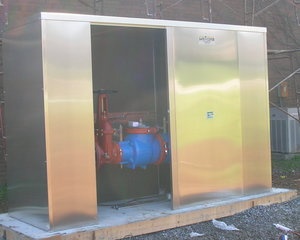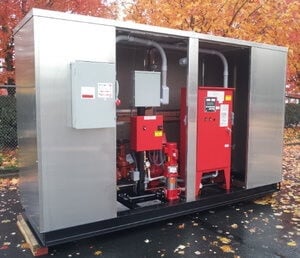Spec valve Covers or pump enclosures once - live with The Cover for years
The drawing shows an insulated cover or protective enclosure - whatever term you use. The bottom line is that the project plan calls for something to protect the valve or pump system. As a project engineer you probably check with a colleague to see what type has been used in the past. You probably also turn to the internet to learn more about your options.
Your goal at that point is to satisfy the spec. However, there's another perspective worth considering - and one that will live with the consequences, good and/or bad, of your selection for quite some time. That's the perspective of the maintenance team.
In our experience there are 3 general maintenance considerations when selecting valve covers, aluminum pump enclosures, or protection for other equipment. They include:
- Preventative maintenance
- Repairs
- Climate control
1. Preventative maintenance - make it easy so it happens
 It's simple. The easier it is to do the maintenance, the more likely it's going to be done according to schedule and completely. An industrial custom pump enclosure or valve cover should take into account all PM points (filters, fittings, gauges, drainage cocks, etc.) and ensure that there is ready access to those areas. A great way to do this is to position doors so that the enclosure can be sized to accommodate the equipment (disregarding room to work around it) and yet provide direct maintenance access at those key points.
It's simple. The easier it is to do the maintenance, the more likely it's going to be done according to schedule and completely. An industrial custom pump enclosure or valve cover should take into account all PM points (filters, fittings, gauges, drainage cocks, etc.) and ensure that there is ready access to those areas. A great way to do this is to position doors so that the enclosure can be sized to accommodate the equipment (disregarding room to work around it) and yet provide direct maintenance access at those key points.
2. Repairs - limit downtime and cost
If PMs are simple, this is reality. Sometimes stuff breaks. When that happens, normally workers need more access than a single panel to let them get to the gauges and filters. Some manufacturers can provide panels that can be ganged together for equipment replacement considerations. In fact, the entire length of one or more sides of an enclosure can sometimes be made of removable access panels. What if a large portion of the fire pump system, water tank, or air compressor needs to be replaced? Repairmen may well need to reach in from above to hoist components out, and then to lower replacements back in. That means you either have to tear the enclosure apart, or you design that capability in up front. Why not? If you can still economically meet ASSE standard 1060 why wouldn't you design a custom enclosure with access from above into valve and pump covers? This and other specific design considerations are covered in our pump covers checklist.
3. Climate control - provide the optimal environment for your equipment
 Temperature extremes can significantly shorten the life span of certain equipment, or lead to immediate failure. Winterization is a common enclosure requirement - and that means a heater unless you use swaddling blankets for your equipment. But matching the enclosure heater to the conditions (wattage, wet environment protection, heating the slab, etc.) often requires a bit more than a casual guess. This is true for the opposite as well. Venting excess heat with louvers or fans may keep your enclosure cool enough to prevent damage, but increasingly equipment is controlled with sensitive electronics which may have maximum ambient operating temps. Air conditioning your enclosure may make sense as well.
Temperature extremes can significantly shorten the life span of certain equipment, or lead to immediate failure. Winterization is a common enclosure requirement - and that means a heater unless you use swaddling blankets for your equipment. But matching the enclosure heater to the conditions (wattage, wet environment protection, heating the slab, etc.) often requires a bit more than a casual guess. This is true for the opposite as well. Venting excess heat with louvers or fans may keep your enclosure cool enough to prevent damage, but increasingly equipment is controlled with sensitive electronics which may have maximum ambient operating temps. Air conditioning your enclosure may make sense as well.
Challenge traditional assumptions
There are two traditional assumptions that crop up at this point. First, optimizing the pump enclosure to accommodate all these factors means a highly customized and expensive cover with a long lead-time. The highly customized part is right. However, it's typically not nearly as costly as engineers assume. You should have pricing and drawings within a couple days of asking - and the enclosure itself shouldn't take more than 2-3 weeks to build. Although it's spread across different budgets, of course, the savings in long term maintenance often dwarfs any customization cost.
Second is the assumption that in order to deliver all this convenience for the maintenance team, valve covers or pump covers will have to be significantly over sized. That is true for some traditional building or shelter styles. A modular industrial enclosure, however, can be designed so that doors and access panels are placed directly in front of components which require maintenance. That means that with only required operational clearance the enclosure can be sized efficiently, yet panels and doors open to allow full and unconstrained maintenance access as required.




